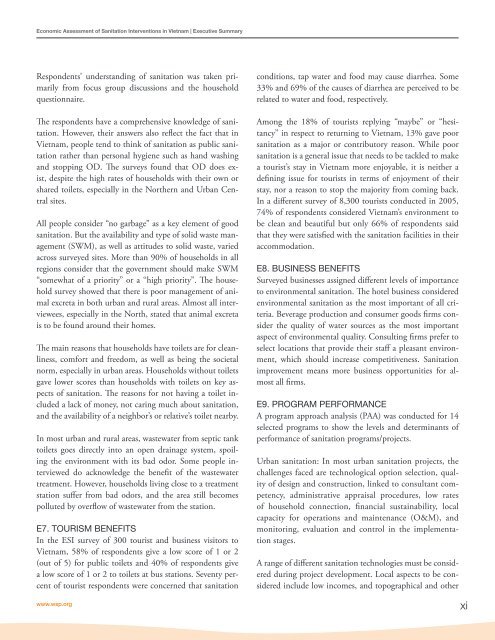Economic Assessment of Sanitation Interventions in Vietnam - WSP
Economic Assessment of Sanitation Interventions in Vietnam - WSP
Economic Assessment of Sanitation Interventions in Vietnam - WSP
You also want an ePaper? Increase the reach of your titles
YUMPU automatically turns print PDFs into web optimized ePapers that Google loves.
<strong>Economic</strong> <strong>Assessment</strong> <strong>of</strong> <strong>Sanitation</strong> <strong>Interventions</strong> <strong>in</strong> <strong>Vietnam</strong> | Executive SummaryRespondents’ understand<strong>in</strong>g <strong>of</strong> sanitation was taken primarilyfrom focus group discussions and the householdquestionnaire.The respondents have a comprehensive knowledge <strong>of</strong> sanitation.However, their answers also reflect the fact that <strong>in</strong><strong>Vietnam</strong>, people tend to th<strong>in</strong>k <strong>of</strong> sanitation as public sanitationrather than personal hygiene such as hand wash<strong>in</strong>gand stopp<strong>in</strong>g OD. The surveys found that OD does exist,despite the high rates <strong>of</strong> households with their own orshared toilets, especially <strong>in</strong> the Northern and Urban Centralsites.All people consider “no garbage” as a key element <strong>of</strong> goodsanitation. But the availability and type <strong>of</strong> solid waste management(SWM), as well as attitudes to solid waste, variedacross surveyed sites. More than 90% <strong>of</strong> households <strong>in</strong> allregions consider that the government should make SWM“somewhat <strong>of</strong> a priority” or a “high priority”. The householdsurvey showed that there is poor management <strong>of</strong> animalexcreta <strong>in</strong> both urban and rural areas. Almost all <strong>in</strong>terviewees,especially <strong>in</strong> the North, stated that animal excretais to be found around their homes.The ma<strong>in</strong> reasons that households have toilets are for cleanl<strong>in</strong>ess,comfort and freedom, as well as be<strong>in</strong>g the societalnorm, especially <strong>in</strong> urban areas. Households without toiletsgave lower scores than households with toilets on key aspects<strong>of</strong> sanitation. The reasons for not hav<strong>in</strong>g a toilet <strong>in</strong>cludeda lack <strong>of</strong> money, not car<strong>in</strong>g much about sanitation,and the availability <strong>of</strong> a neighbor’s or relative’s toilet nearby.In most urban and rural areas, wastewater from septic tanktoilets goes directly <strong>in</strong>to an open dra<strong>in</strong>age system, spoil<strong>in</strong>gthe environment with its bad odor. Some people <strong>in</strong>tervieweddo acknowledge the benefit <strong>of</strong> the wastewatertreatment. However, households liv<strong>in</strong>g close to a treatmentstation suffer from bad odors, and the area still becomespolluted by overflow <strong>of</strong> wastewater from the station.E7. TOURISM BENEFITSIn the ESI survey <strong>of</strong> 300 tourist and bus<strong>in</strong>ess visitors to<strong>Vietnam</strong>, 58% <strong>of</strong> respondents give a low score <strong>of</strong> 1 or 2(out <strong>of</strong> 5) for public toilets and 40% <strong>of</strong> respondents givea low score <strong>of</strong> 1 or 2 to toilets at bus stations. Seventy percent<strong>of</strong> tourist respondents were concerned that sanitationwww.wsp.orgconditions, tap water and food may cause diarrhea. Some33% and 69% <strong>of</strong> the causes <strong>of</strong> diarrhea are perceived to berelated to water and food, respectively.Among the 18% <strong>of</strong> tourists reply<strong>in</strong>g “maybe’’ or “hesitancy’’<strong>in</strong> respect to return<strong>in</strong>g to <strong>Vietnam</strong>, 13% gave poorsanitation as a major or contributory reason. While poorsanitation is a general issue that needs to be tackled to makea tourist’s stay <strong>in</strong> <strong>Vietnam</strong> more enjoyable, it is neither adef<strong>in</strong><strong>in</strong>g issue for tourists <strong>in</strong> terms <strong>of</strong> enjoyment <strong>of</strong> theirstay, nor a reason to stop the majority from com<strong>in</strong>g back.In a different survey <strong>of</strong> 8,300 tourists conducted <strong>in</strong> 2005,74% <strong>of</strong> respondents considered <strong>Vietnam</strong>’s environment tobe clean and beautiful but only 66% <strong>of</strong> respondents saidthat they were satisfied with the sanitation facilities <strong>in</strong> theiraccommodation.E8. BUSINESS BENEFITSSurveyed bus<strong>in</strong>esses assigned different levels <strong>of</strong> importanceto environmental sanitation. The hotel bus<strong>in</strong>ess consideredenvironmental sanitation as the most important <strong>of</strong> all criteria.Beverage production and consumer goods firms considerthe quality <strong>of</strong> water sources as the most importantaspect <strong>of</strong> environmental quality. Consult<strong>in</strong>g firms prefer toselect locations that provide their staff a pleasant environment,which should <strong>in</strong>crease competitiveness. <strong>Sanitation</strong>improvement means more bus<strong>in</strong>ess opportunities for almostall firms.E9. PROGRAM PERFORMANCEA program approach analysis (PAA) was conducted for 14selected programs to show the levels and determ<strong>in</strong>ants <strong>of</strong>performance <strong>of</strong> sanitation programs/projects.Urban sanitation: In most urban sanitation projects, thechallenges faced are technological option selection, quality<strong>of</strong> design and construction, l<strong>in</strong>ked to consultant competency,adm<strong>in</strong>istrative appraisal procedures, low rates<strong>of</strong> household connection, f<strong>in</strong>ancial susta<strong>in</strong>ability, localcapacity for operations and ma<strong>in</strong>tenance (O&M), andmonitor<strong>in</strong>g, evaluation and control <strong>in</strong> the implementationstages.A range <strong>of</strong> different sanitation technologies must be considereddur<strong>in</strong>g project development. Local aspects to be considered<strong>in</strong>clude low <strong>in</strong>comes, and topographical and otherxi
















